A delicious Korean seaweed rice roll packed with savory pork belly, ssamjang, eggs, vegetables and pickled daikon. This pork belly kimbap is great as a main dish, meal or snack and ready in 30 minutes with cooked rice!
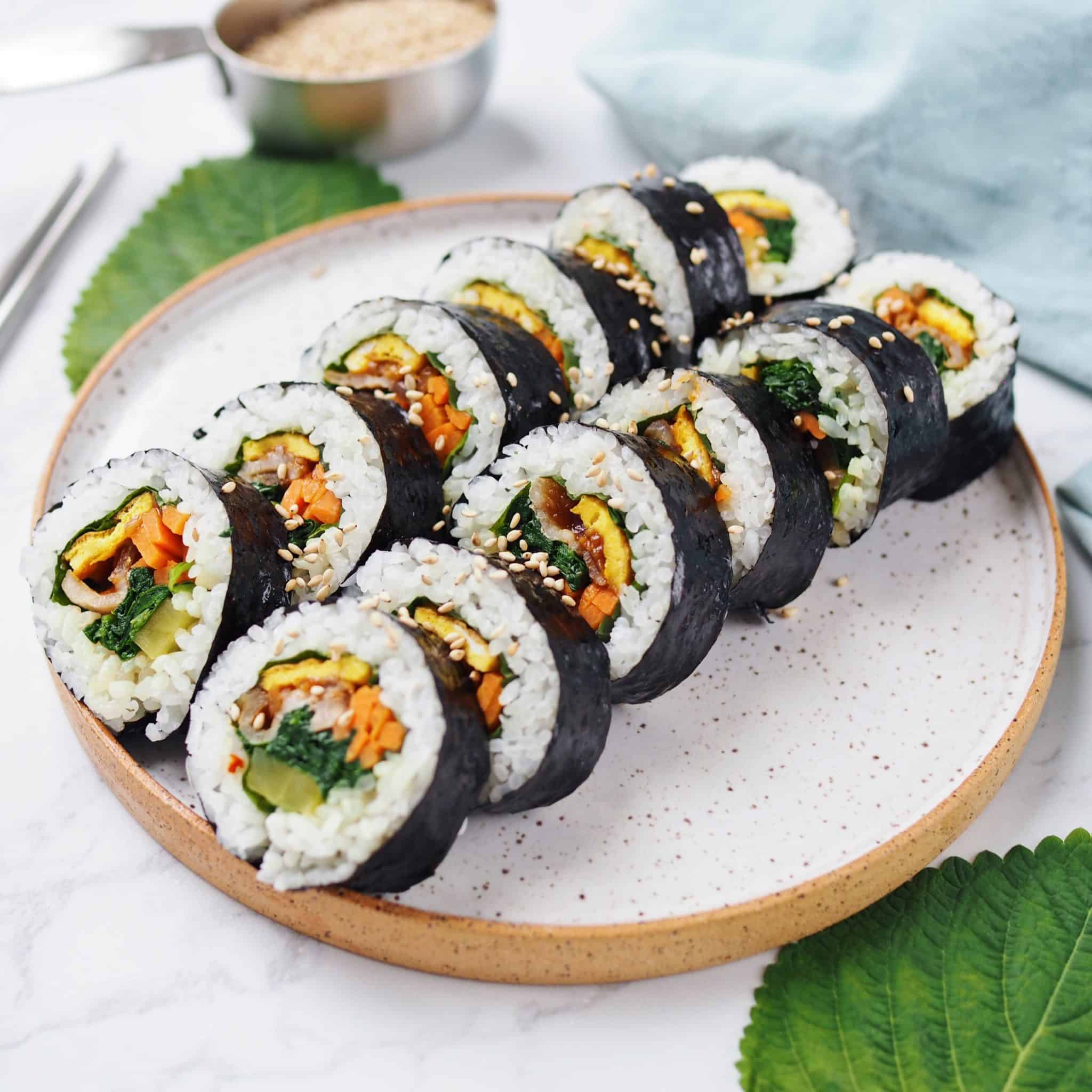
Jump to:
What is Pork Belly Kimbap?
My delicious pork belly kimbap contains pork belly, eggs, carrots, spinach, pickled daikon, perilla leaves and ssamjang! It's absolutely delicious and satisfying.
Kimbap (aka Gimbap) is a delicious seaweed rice roll that contains a variety of cooked ingredients and originates from Korea. "Kim" means "seaweed" and "Bap" means rice in Korean.

Kimbap is usually made with leftover cooked ingredients and it's perfect for a lunchbox or picnic food since it can be eaten at room temperature as a complete meal.
It's personally one of my favorite Korean foods to eat as it's portable and really hits the spot! I also share many kimbap recipes on the blog so check them out below.
This Korean dish is really simple to make at home and the only tricky part is rolling the kimbap but with enough practice, you'll get the hang of it!
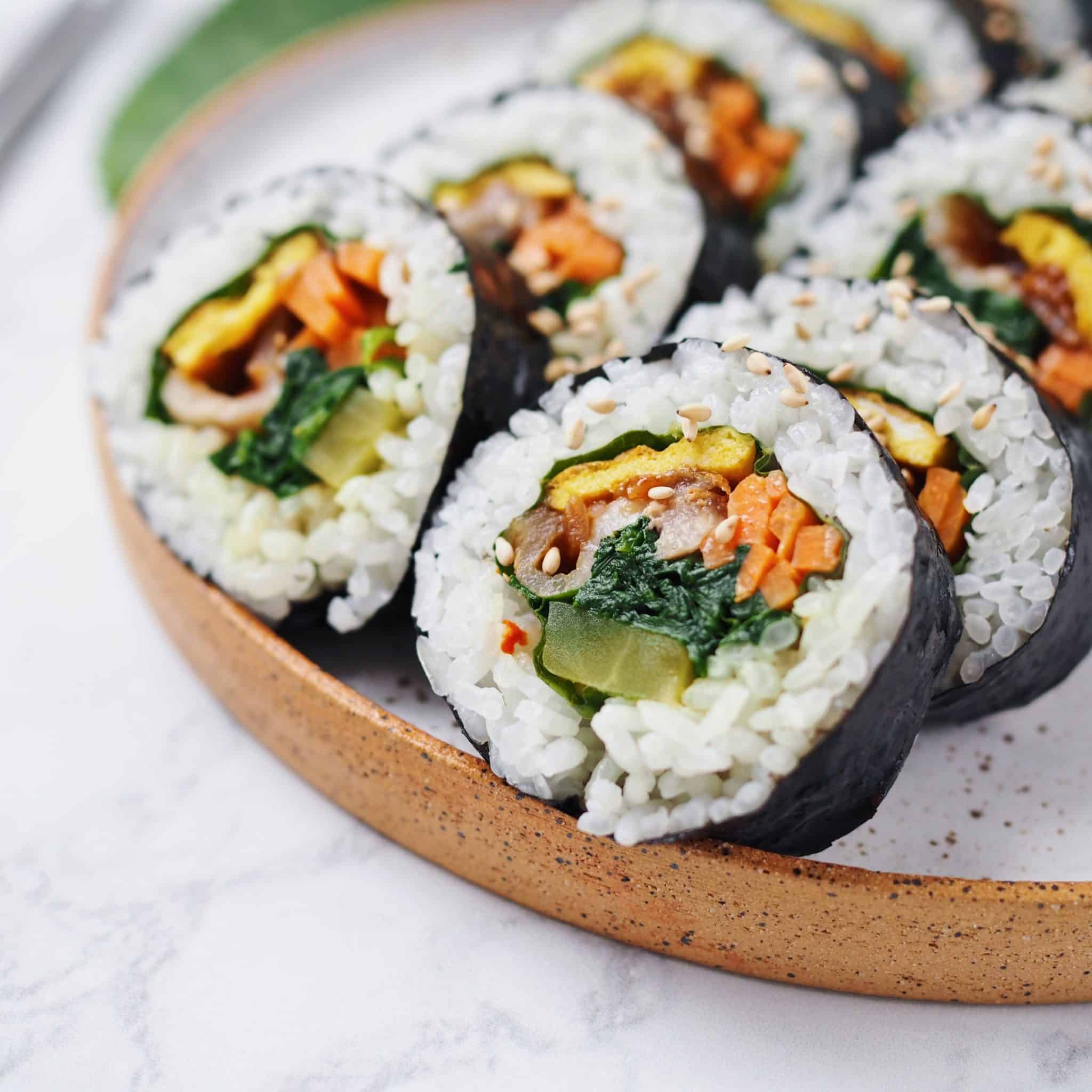
Ingredients & Substitutes
Please scroll down to below recipe card for exact measurements.
- Gim: aka dry roasted seaweed in Korean or this is also known as "nori" in Japanese.
- Sesame oil: for brushing the finished kimbap roll.
- Sesame seeds: for garnishing the roll.
Seasoned rice
- Cooked short-grain rice: aka sushi rice or Calrose rice. Avoid using long-grain rice for this or it won't stick together in the roll. Do not use glutinous rice as it's too sticky.
- Sesame oil: for that nutty flavor! If you're allergic, please replace with neutral tasting oil like avocado oil, vegetable oil, canola oil, grapeseed oil or sunflower oil. Avoid using olive oil.
- Salt
Kimbap Fillings
- Fresh perilla leaves: this is a pointy spade-shaped green leaf that you can find at most Korean grocery stores in the produce aisle. It's got a refreshing mint flavor to balance the savoriness of the pork belly.
- Thin pork belly strips: these come pre-sliced at most grocery stores. You can also get the pork belly slabs and ask the butcher to slice them into ¼-inch thin pieces. Make sure to get the kind where the thick top skin has been removed. Or substitute with thinly sliced pork shoulder, spam, or ham.
- Large eggs
- Sesame oil: for that nutty flavor! If you're allergic, please replace with neutral tasting oil like avocado oil, vegetable oil, canola oil, grapeseed oil or sunflower oil. Avoid using olive oil.
- Carrots: sliced into matchsticks.
- Spinach leaves: baby spinach or regular spinach with the roots trimmed off will work.
- Pickled daikon radish: these are yellow and come in long strips pre-cut for kimbap. They're submerged in a pickled liquid and you can find them packaged in the refrigerated section at the Korean market. Or substitute with the ones that are circular and cut them into 1-cm wide pieces like how I did in the visuals below.
- Ssamjang: this is a fermented soybean paste that contains a mild spice. It comes in a green tub at the Korean grocery store in the sauce aisle or where you'd find gochujang.
- Neutral oil: like avocado oil, sunflower oil, peanut oil, vegetable oil or canola oil with a high smoke point. Avoid olive oil or any heavy scented oils with a low smoke point.
Note: Most Asian grocery stores will carry most of the Asian specific ingredients.
Expert Tips
- Use thinly sliced pork belly for easier rolling! Avoid using thick slabs of pork belly.
- Season the cooked rice with salt and sesame oil while it's hot. This ensures the seasoning seeps into the rice better.
- Don't overcook the pork belly. They shouldn't be too crispy or it'll be too chewy to slice the kimbap easily.
- Evenly spread the seasoned rice across the dry roasted seaweed.
- Use a sushi mat or bamboo mat to help you roll the kimbap.
- Don't overstuff the kimbap or it'll burst apart.
- Don't skip brushing the gim or nori with sesame oil. This makes the slicing easier and offers flavor to the kimbap.
- Use a sharp oiled knife to cut the kimbap because the oil prevents the rice from sticking to the knife.
Instructions
Below are step-by-step instructions on how to make pork belly kimbap:

- First season hot cooked rice with sesame oil and salt. Mix well with a rice paddle. Set aside and keep covered so it stays moist and warm.

- Heat 2 teaspoon of vegetable oil in a large pan on medium heat. Pour beaten eggs into the hot pan and swirl the eggs around the pan into a thin pancake. Flip the egg pancake over to cook through on the other side until golden. Transfer to a cutting board and slice egg pancake into ¾-inch wide strips. Set aside.
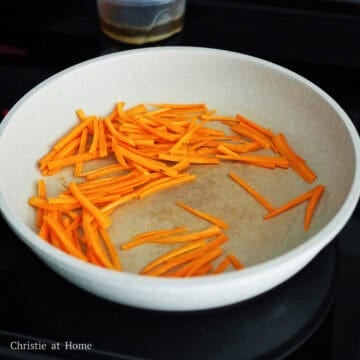
- Next reduce to low-medium heat, add 1 teaspoon sesame oil and carrot matchsticks. Cook until they're softened, 1-2 minutes. Remove and set aside on a large plate.
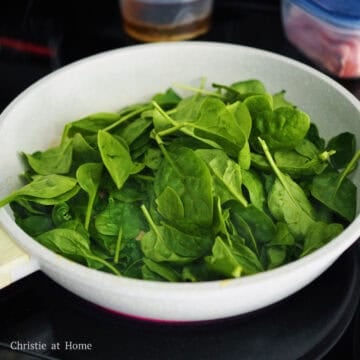
- Next in the same pan set over medium heat, add 1 teaspoon sesame oil and add baby spinach. Cook until softened and dark green. Remove and set aside.
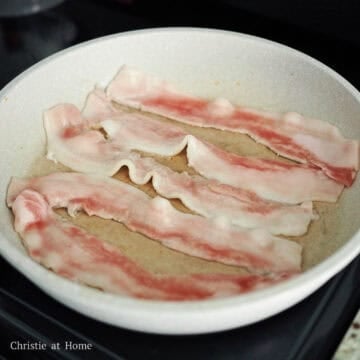
- On medium heat, cook your pork belly until it's no longer pink and some of the fat has rendered off, about 4-5 minutes. Remove and place the pork belly strips on a plate lined with paper towel to soak up excess grease.
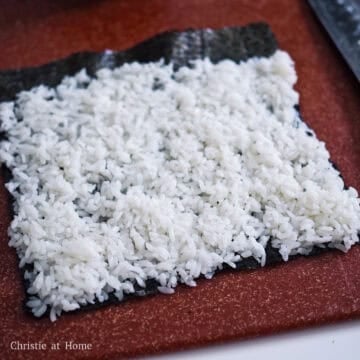
- On a clean working surface, lay out a sheet of gim or nori in a horizontal position (optional: if you have a bamboo mat, rest the gim or nori on the mat). Spread about ¾ cup of seasoned rice on your sheet leaving a 1-inch border at the end of the sheet.
Filling the Kimbap

- Place two perilla leaves in the middle of the rice, followed by two strips of the cooked egg and one strip of pork belly. Use a knife and spread 1 tablespoon of ssamjang paste over your pork belly. Then layer with sautéed carrots, spinach and a strip of pickled daikon.
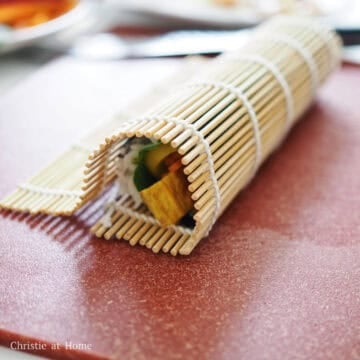
- With the end closest to you, begin rolling the kimbap keeping the filling ingredients inside the roll, until you reach the very end. Let the roll sit on the empty border so the heat seals the flap onto the roll.
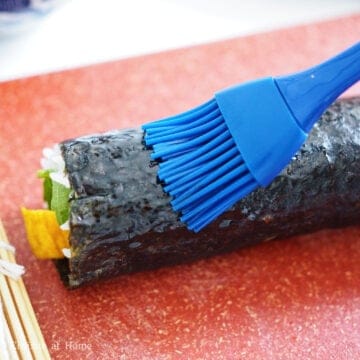
- Evenly brush enough sesame oil all over the kimbap and garnish with sesame seeds.
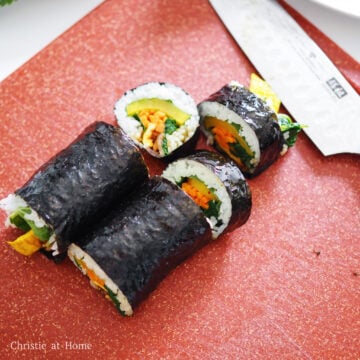
- With an oiled sharp knife, slice the kimbap into ½-inch thick pieces and enjoy! Repeat this process to create three more rolls.
Storage
- Gimbap is best consumed same day as the rice will go hard when stored in the fridge.
- Leftovers last 1-2 days stored in an airtight container in the refrigerator.
- To reheating leftover kimbap on the stove top:
- Heat a non stick pan on medium heat lightly greased with neutral oil.
- In a separate bowl, beat an egg and dip one piece of the kimbap into the egg so it's coated with egg on both sides.
- Place coated kimbap into the heated pan and fry on both sides until golden brown and the egg is cooked through.
- To speed up the reheating process, cover the kimbap with a lid so the steam can reheat and soften the rice again.
- Freezer-friendly? I don't recommend freezing kimbap because the rice will turn hard even after reheating.
Pairing Suggestions
Pork belly kimbap serves well with other types of kimbap or Korean side dishes like:
FAQ
You may up to 2 days in advance stored in an airtight container in the fridge but a warning: it won't taste as good as fresh kimbap.
So I recommend to prepare the seasoned rice and filling components up to 4 days in advance and store into separate airtight containers. Then on the day of serving, reheat the seasoned rice in the microwave for 2-3 minutes covered along with the other cooked ingredients. Next, assemble the rolls as instructed and they will taste almost as good as freshly made kimbap rolls.
Kimbap, aka gimbap, is a savoury rice roll that comes from Korea. It contains cooked and mostly cooked vegetables with some pickled ingredients. Then seasoned with sesame oil and sesame seeds.
On the other hand, sushi is from Japan and contains mostly raw and some cooked ingredients. It's usually dipped in soy sauce, wasabi or paired with pickled ginger unlike kimbap.
Yes, feel free to substitute the pork belly with chicken, beef, or extra-firm tofu.
Other recipes you may like
📖 Recipe

Easy & Simple Pork Belly Kimbap
Ingredients
- 4 sheets gim or nori
- 2 teaspoon sesame oil for seasoning finished kimbap roll
- 1 teaspoon sesame seeds for garnish
Rice
- 3 cups cooked short grain rice (or see below Notes for quantity of uncooked rice required)
- ½ teaspoon salt
- 2 teaspoon sesame oil
Kimbap Filling
- 8 perilla leaves washed, dried with stems trimmed
- 3 large eggs beaten
- ¾ cup carrot julienned
- 5 oz baby spinach or regular spinach with ends trimmed (packed)
- 4 pork belly strips thinly sliced
- 4 strips pickled daikon radish or use circular ones and cut into 1-cm thick pieces
- 4 tablespoon ssamjang paste
- 2 teaspoon sesame oil for cooking carrots and spinach
- 2 teaspoon vegetable oil to cook the eggs
Instructions
- First season hot cooked rice with sesame oil and salt. Mix well with a rice paddle. Set aside and keep covered so it stays moist and warm.
- Heat 2 teaspoon of vegetable oil in a large pan on medium heat. Pour beaten eggs into the hot pan and swirl the eggs around the pan into a thin pancake. Flip the egg pancake over to cook through on the other side until golden. Transfer to a cutting board and slice egg pancake into ¾-inch wide strips. Set aside.
- Next reduce to low-medium heat, add 1 teaspoon sesame oil and carrot matchsticks. Cook until they're softened, 1-2 minutes. Remove and set aside on a large plate.
- Next in the same pan set over medium heat, add 1 teaspoon sesame oil and add baby spinach. Cook until softened and dark green. Remove and set aside.
- On medium heat, cook your pork belly until it's no longer pink and some of the fat has rendered off, about 4-5 minutes. Remove and place the pork belly strips on a plate lined with paper towel to soak up excess grease.
- On a clean working surface, lay out a sheet of gim or nori in a horizontal position (optional: if you have a bamboo mat, rest the gim or nori on the mat). Spread about ¾ cup of seasoned rice on your sheet leaving a 1-inch border at the end of the sheet.
- Place two perilla leaves in the middle of the rice, followed by two strips of the cooked egg and one strip of pork belly. Use a knife and spread 1 tablespoon of ssamjang paste over your pork belly. Then layer with sautéed carrots, spinach and a strip of pickled daikon.
- With the end closest to you, begin rolling the kimbap keeping the filling ingredients inside the roll, until you reach the very end. Let the roll sit on the empty border so the heat seals the flap onto the roll.
- Evenly brush enough sesame oil all over the kimbap and garnish with sesame seeds.
- With an oiled sharp knife, slice the kimbap into ½-inch thick pieces and enjoy! Repeat this process to create three more rolls.



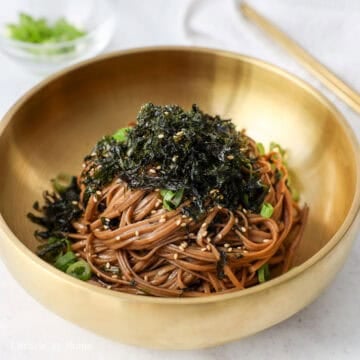


Heidi | The Frugal Girls
I love all of the fun flavors in the kimbap fillings... and the perfect round shape would make these so perfect to serve as a party appetizer this holiday season!! 💕
Mark
This was so good. I made it at home and it was pretty easy.
Julia
As I love so much pork belly, this recipe has cought my eye and have to try it. It must be so delicious with savoury rice!
Des | itsbetterinheels
Wow, very cool. I never knew the difference between kimbap and sushi! Thanks for the information and your recipe! It looks delicious and I'm totally bookmarking this page to try!!
Thanks for sharing doll!
Des | https://www.itsbetterinheels.com
Dennis Yannakos
I'm so addicted to this dish!
Cool Kitchen Utensils